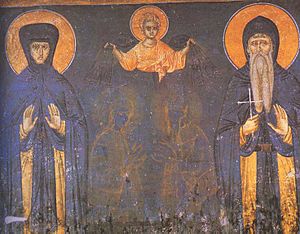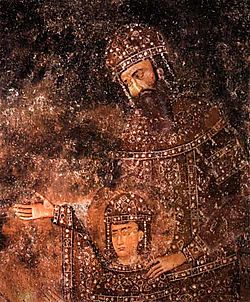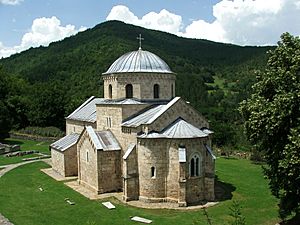Helen of Anjou facts for kids
Quick facts for kids Helen of Anjou |
|
|---|---|

Helena and her son, King Stefan Milutin. Fresco from Gračanica monastery.
|
|
| Queen consort of Serbia | |
| Born | c. 1235 |
| Died | 8 February 1314 Church of St. Nicholas, Shkodër |
| Burial | Gradac Monastery |
| Spouse | Stefan Uroš I |
| Issue |
|
| Religion | Roman Catholic, then Serbian Orthodox |
| Signature |  |
Helen of Anjou (Serbian: Јелена Анжујска / Jelena Anžujska, born around 1235, died February 8, 1314) was a powerful queen in medieval Serbia. She was the wife of King Stefan Uroš I, who ruled the Serbian Kingdom from 1243 to 1276. Helen and Uroš had two sons, Stefan Dragutin and Stefan Milutin, who both later became kings of Serbia.
After her husband's reign, Helen became a dowager-queen. She governed the regions of Zeta and Travunija until 1308. Queen Helen was known for her kindness and for supporting different religions. She built the Gradac monastery and is honored as a saint by the Serbian Orthodox Church.
Life of Queen Helen
Where Was Queen Helen From?
The exact family background of Queen Helen is not fully known. Writings from her time say she came from a "French family" and that her relatives were of "royal or imperial blood."
Some historians believe she was connected to the Angevine royal family. This idea came about because Angevine kings of Naples called her their "dear cousin" in letters. This is why she is often called "Helen of Anjou."
We do know that Helen had a sister named Maria. Maria visited Helen in Serbia in 1280. Documents show that King Charles I of Sicily also called Maria his "cousin."
Helen as Queen of Serbia
Helen married King Stefan Uroš I of Serbia between 1245 and 1250. In 1276, a conflict happened between King Uroš and their oldest son, Stefan Dragutin. King Uroš decided to step down from the throne and passed away in 1280.

After her husband left the throne, Helen became a dowager-queen. She was given control over the regions of Zeta and Travunia. She managed these areas very well until 1308. These regions had people who followed both the Serbian Orthodox faith and the Roman Catholic faith. Helen was known for being fair to everyone, no matter their religion.
Later in her life, Helen became a nun at the Church of St. Nicholas in Skadar. She passed away there on February 8, 1314. The Serbian Orthodox Church later made her a saint. Her special day of remembrance is November 12 (or October 30 by the old calendar).
Queen Helen did a lot to help the culture of medieval Serbia grow. She had her own library and encouraged people to copy books in monasteries. She even started the first school for girls in medieval Serbia!
She had palaces in places like Brnjak (also called "Brnjaci") and the town of Jeleč. Like other members of the Nemanjić dynasty, she built and supported many monasteries and churches. She built the Gradac Monastery, where she was buried. She also built the Church of St. Nicholas in Skadar and fixed up the Monastery of Saints Sergius and Bacchus. She repaired many churches and monasteries around Lake Skadar that had been damaged by the Mongol invasion of 1242.
Helen's Children
Queen Helen and King Stefan Uroš I had at least three children:
- Stefan Dragutin, who became the Serbian king from 1276 to 1282.
- Stefan Milutin, who became the Serbian king from 1282 to 1321.
- Brnjača, a daughter.


